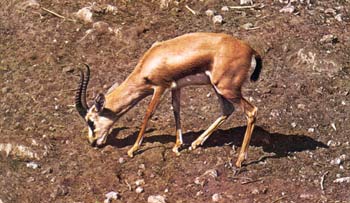| |
|
Summer daytime temperatures are c. 40 to 50
degrees C., in the winter 16- 24 degrees, falling to 5 degrees at
night. The present average rainfall is about 40 to 50 mm. per year
at Aqaba, and rather more at the Dead Sea. A high proportion of this
falls in storms, and these produce high run-off from the eastern slopes,
violent floods in the wadis which discharge into the Wadi Arabah,
the formation of temporary lakes, and recharge of ground water.
|
| |
| |
As a result, the vegetation is denser
than might be expected in such a dry region. There are also
a number of springs, especially at En Hazeva and Wadi Fidan
and near the south end of the Dead Sea. Due to high run-off
from the mountains, the ground water is in some places near
enough to the surface to be obtained from shallow wells. The
Wadi Arabah vegetation consists largely of sagebrush, camel
thorns and acacia.
|
|
| |
|
Wastewater
management in the Wadi Musa
| The main threat to the
flora and fauna of the Wadi Arabah is the lack of water. Both
the fast-growing population of Jordan, and the pressure of tourism,
particularly around Petra, are an enormous strain on the scarce
water resources in the region. In an effort to release the strain
on Jordan's fast depleting aquifers, USAID and the Water Authority
of Jordan started a project to reuse waste water from the region
in an ecological farming project. In 2002 a demonstration farm
was initiated, which is now up and running. It is being farmed
by a local farmers' association, using wastewater from the plant. |
|
|
| |
Wild animals are now scarce; a few gazelles
are still hunted, and there are hares, foxes, a few wolves and
hyenas, and in the mountains hyrax, mouflon (a type of wild
sheep), and ibex.
|
|
| |
 |
Gazelle
|
| |
| Hare |
|
| |
|
Fox |
|
| |
| |
Wolf |
|
| |
|
Hyena |
|
| |
| |
Hyrax |
|
| |
|
Mouflon |
|
| |
| |
Ibex |
|